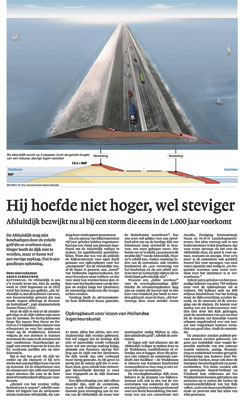The advisory committee for the future of the Afsluitdijk presented its final report last week. The iconic dike between IJsselmeer and Waddenzee will not be made higher, but more solid, as the Dutch newspaper NRC Handelsblad reports.
Professor Han Vrijling (Civil Engineering and Geosciences) was ‘a little amazed’ by the chosen option. Rijkswaterstaat had made a shortlist of four renovation proposals submitted by various consultancies and consortia in response to a tender four years ago. There were designs with concrete storm shields, with nature reserves on either sides of the dike, energy plants running on osmotic power, and a storage lake for hydropower. Vrijling and his team were asked to make feasibility studies for the shortlisted designs. When he saw them, Vrijling declared: “This is the end of an era. We’re so rich that we cannot simply renovate a dike without attaching a fancy ecological or sustainable solution to it.” Still, the group wasn’t asked for comments, just for an assessment of the feasibility of each of the plans. They all got green light from Vrijling. But come the day of the final report and yet another design emerged as the winner – a design that was in fact not on the shortlist.
The graphics show that the dike will be reinforced on the inner side and that the inner slopes will be made less steep. The idea behind this is that if waves overtop the dike, the water rolling down the other side will not cause damage.
“You want to prevent breaching of the dike,” explains Professor Marcel Stive (CEG). “That is what happened in Zeeland in 1953: water overtopping the dike eroded the inside of the dike, resulting in an opening through which the water rushed in.” Shortly after that disastrous flood, engineer Ton Edelman proposed to modify the dikes to make them resistant to overtopping water.
Despite its simplicity, Edelman’s plan has not yet been put into practice, except for an exceptionally broad multifunctional dike in Maassluis. Notwithstanding its invention more than half a century ago, an overtopping resistant dike can be called pretty innovative, says Stive, who called the committee’s recommendation “a pretty optimal choice.” And yes, it was the cheapest option as well. Originally, before the crisis hit, the previous Cabinet reserved 750 million euros for the makeover. The budget has now been reduced to 600 million. Prof. Stive is glad that the sober character of the Afsluitdijk will remain unchanged. “A straight line on the map and through space,” he calls it. And as an active bicyclist he appreciates the fact that the bicycle path will be constructed between the southern car lane and the IJsselmeer, instead of between the motorway and the dike top. “The noise and pollution is probably less, and the view is better because you’re nearer to the water.”
“It’s the wisest decision,” Vrijling agrees. In fact, he already expected the committee to opt for a cheaper and less ambitious alternative. Having had no detailed information of the plan, he now must rely on drawings in the newspapers, which leaves him wondering how exactly they plan to make the dike resistant to overtopping water. “The first inner slope and the crease at the end of it need to be resilient enough. Soil-mechanically speaking, that is not very simple to achieve.”
De acht hadden het zo naar hun zin in het recreatiegebied dat ze bedachten dat het leuk was om een kampvuur te bouwen. Hout hadden ze niet bij zich, maar bomen genoeg hier, moeten de studenten gedacht hebben. Ze hakten een boom om en maakten een vuur. De politie kon er de humor niet van inzien. Het vuur moest uit en de acht kregen een proces-verbaal. Het is nog niet duidelijk of de studenten moeten betalen voor de schade.



Comments are closed.